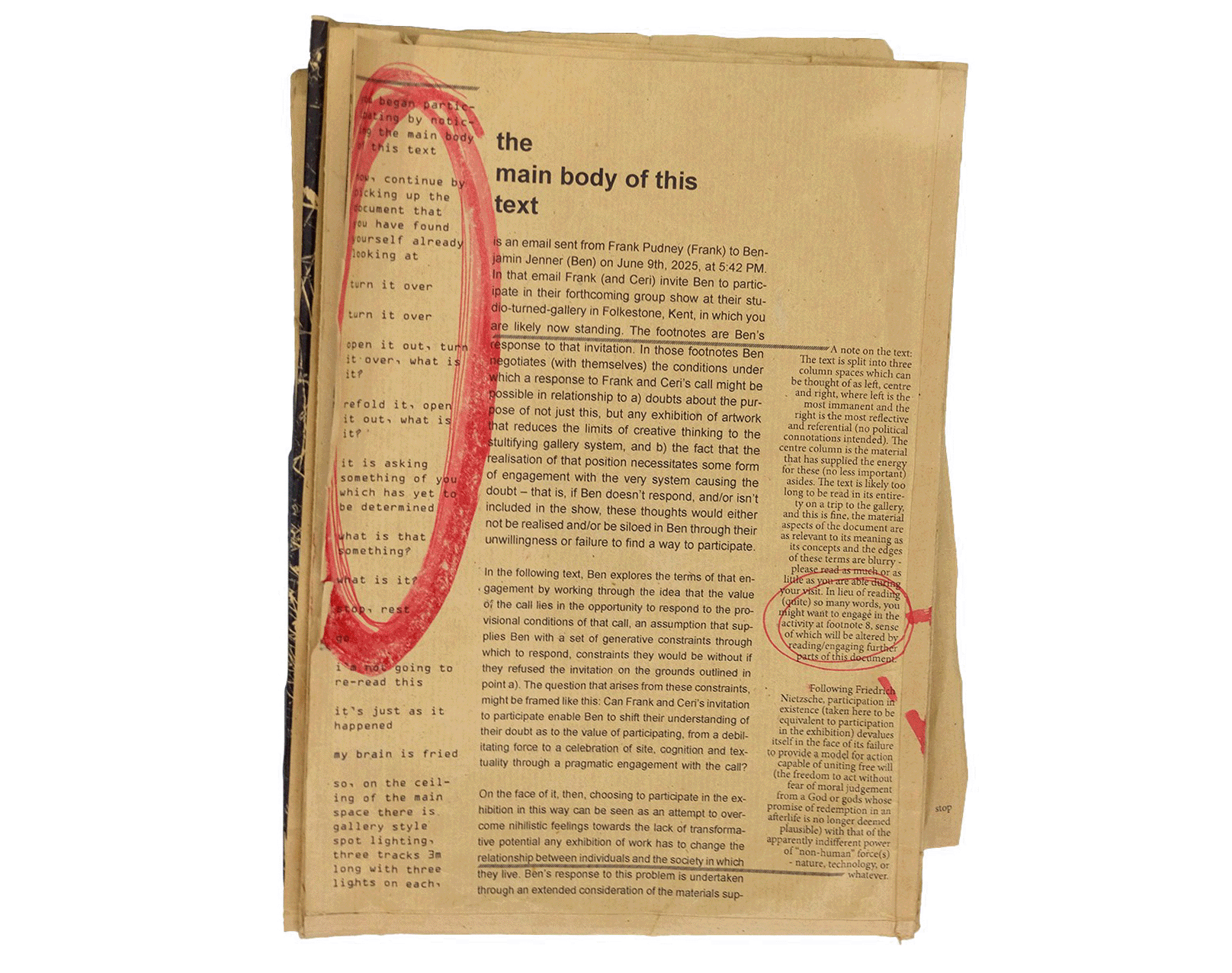
the main body of this text, exhibited at Dover Road Gallery, Folkestone, Kent between 02nd and 10th August 2025.
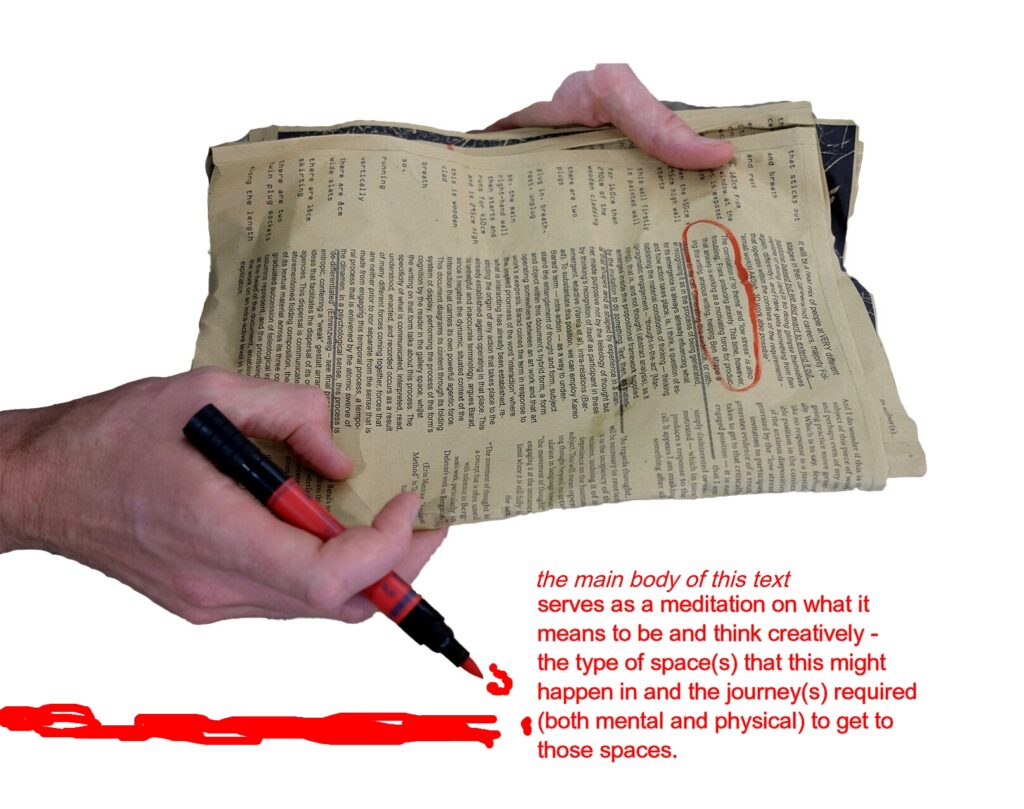
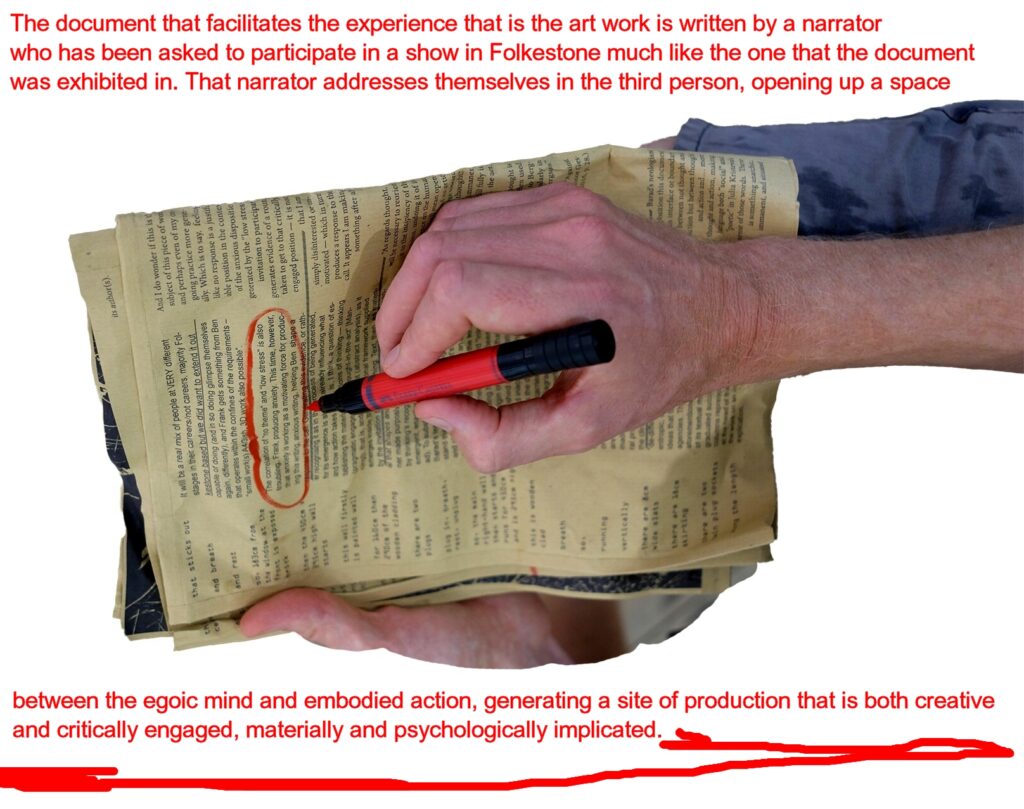
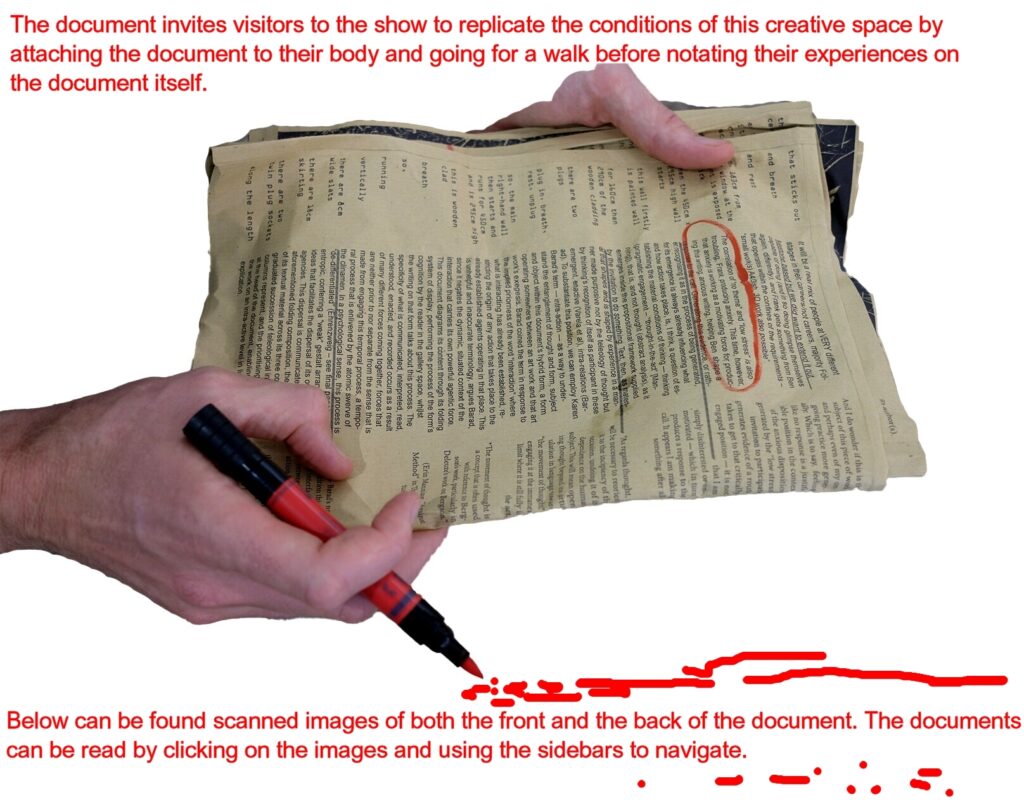
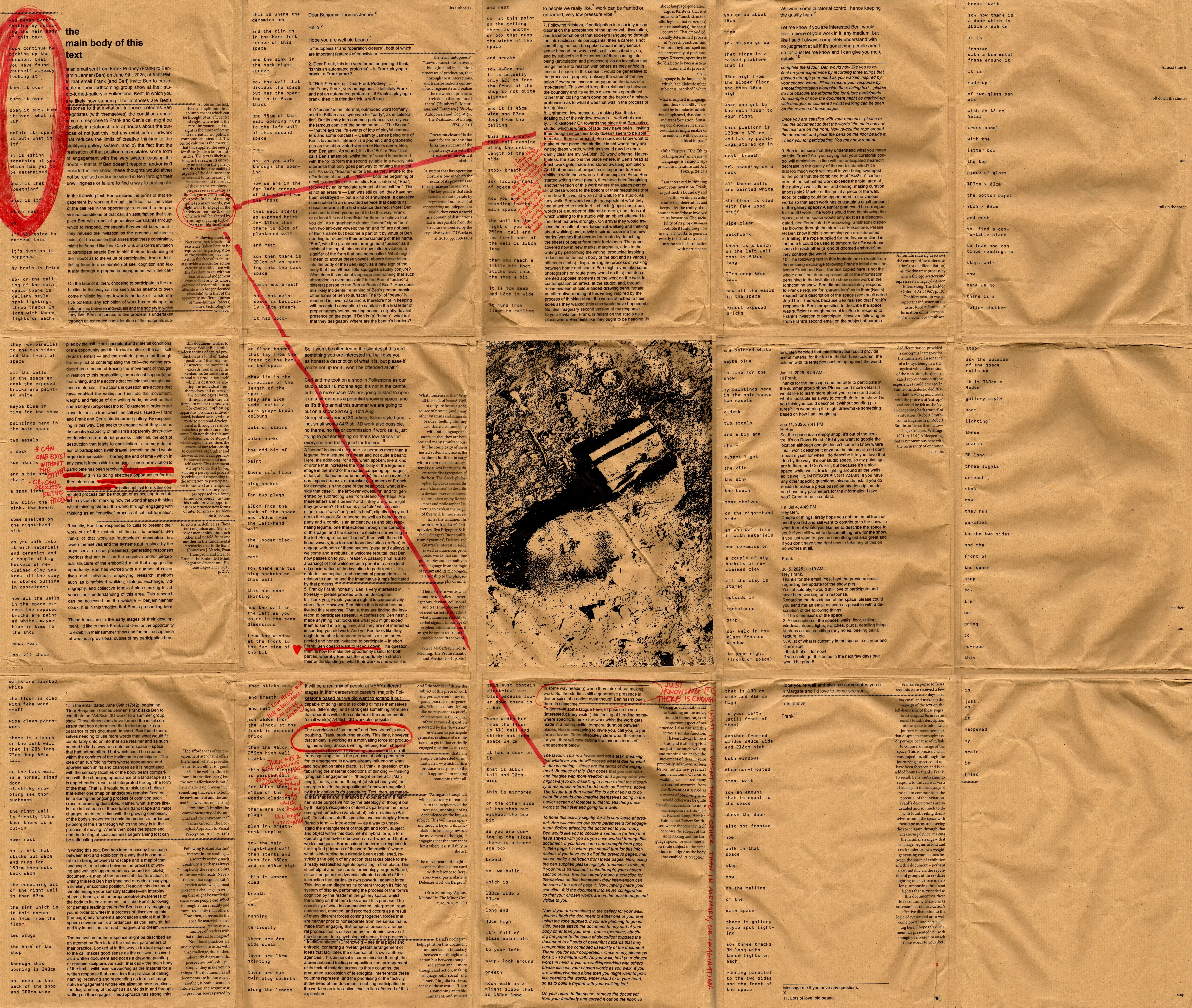
the main body of this text – front
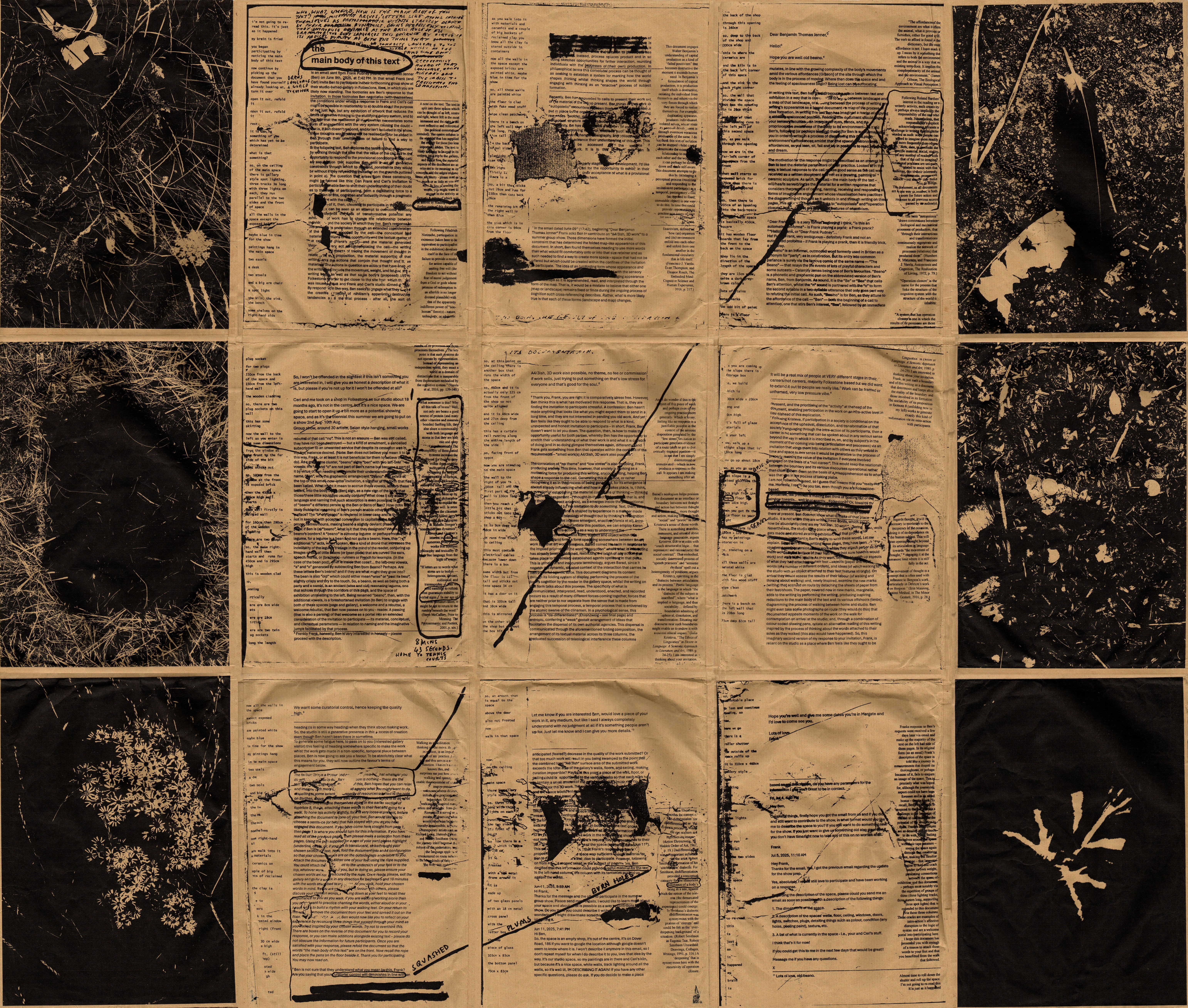
the main body of this text – back
Artist
A collaborative research project with Words as Matter, a Special Interest Group (SIG) of the Language-Based Artistic Research Group. The research was shared as part of the 16th Society of Artistic Research gathering in Porto, Portugal in May 2025:
Words as Matter // Mariana Renthel | Erika Tsimbrovsky | Cecilie Fang Jensen | Benjamin Jenner | Danica Maier | Antrianna Moutoula | Anouk Hoogendoorn

During May 2024, Anouk wrote letters to the members of Words as Matter in a park, guided by the wind in an open collaboration with the air’s uncanny currents. These traces, shaped by movement and chance, became messages to the members of the group: Mariana, Erika, Cecilie, Benjamin, Danica, Antrianna.
For research purposes, with a playful and creative approach, the group responded with videos, echoing the interplay between intention and elemental forces. This asemic exchange reimagined writing as a dialogue beyond human language. The wind, as co-author, left its mark alongside Anouk’s gestures, while the videos extended the conversation into new mediums and other entities.
As an open experiment, one might invite a force—light, water, sound—to shape letters, filming the process as it unfolds. The group’s video contribution to the above conference can be viewed here: https://www.researchcatalogue.net/view/835089/3594677
i was going to do it…
My contribution to the group video work, entitled i was going to do it…, was motivated by the practice of conceptual art group Collective Actions (CA), and in particular their idea of the ’empty action’: an intervention into a constructed situation that alters participant’s understanding of their role in the unfolding experience. The empty action involves a shift in participant’s understanding of the value of what is being observed and/or happening around them, whereby what was understood to be preamble or preparation (what CA call “extra-demonstrable information”) is suddenly understood (retrospectively now) to have been the main event (what CA call “demonstrable information”). Crucial to the success or failure of the empty action is the ability of group members to place extra-demonstrable elements inside the demonstrable elements without participants suspecting what is taking place ahead of time. The shift in understanding (the transformation of the innocuous into an aesthetic experience) is initiated from inside the (as yet unperceivable) event via the insertion of a normally unremarkable and anti-sensational gesture (such as the signing of a certificate to confirm participation in the event that has just taken place).
The value of the empty action to the creation of an asemic text is in the way it legitimises the possibility of writing with a force in the absence of any understanding that this is what is taking place. That is, it offers the opportunity to write with a force from within the force, to communicate something that is suspended between two types of meaning (my meaning and the meaning brought by the force), without falling into the trap laid by thinking: namely that treating writing as a series of signs for what has been thought after the fact, erases (through the very act of thinking the force) the force and its ‘asemic’ agency.
i was going to do it… Benjamin Jenner, 2025
In i was going to do it… (above) two figures enter a wooded area armed with two pieces of paper, some pens and a camera. They are going for a walk and to have a conversation. Both pieces of paper have the words “cloud, reverse, shutter, light, step, bank, camera, mud” written down the right-hand side; followed by a number from 1 – 9 (see below). In the work, these words operate as signals prompting a period of reflection that includes recalling and writing down the dialogue that led up to the utterance of the word. The aim of the activity is to insert these words into conversation in such a way as to surprise the interlocutor, causing them to reevaluate the purposiveness of the dialogue that lead up to the utterance of the word.

The placement of a signal word by one of the figures inside the dialogue is conceived here as equivalent to the placement of an extra-demonstrable element inside the demonstrable structure of the work. Although both figures are privy to the list of words, placing the words into a sentence that is consistent with the ensuing dialogue takes considerable mental effort, making it less likely that either figure would notice the effort being made by the other to structure the conversation around one of the words. In this way, words that ought to be in thought are able to bypass consciousness with ease on the pretence that they are insignificant (extra-demonstrational) elements of the exchange, a bit like a Trojan Horse rolling unnoticed inside the walls (consciousness) of Troy. Several times during the making of i was going to do it… a signal word was spoken only for the receiver of that word to continue walking, needing to be called back so as to engage in the process of recording and reflection.
The recording of the word’s utterance is undertaken by both figures simultaneously, with each figure writing twice, with both hands (the right hands of both figures write on one piece of paper, the left hands of both on the other) the dialogue that lead up to the word’s utterance. Recalling this dialogue is not a simple task: coupled with the above reference to the fall of Troy as a metaphor for the breaching of thought’s teleology, the dialogue was by definition unremarkable, unmemorable and in no way building up to a significant moment – prior, that is, to the signal words utterance. As such, retrieving the words that make up the dialogue requires a reversal of thought in reference to the loci of the signal word that now (understood as such) reshapes the build up to its utterance. The reshaping of the passage of thought in light of a constructive misapprehension of what has just taken place relinquishes thought’s agency over action, and the agential actions of other forces, generating asemic writing. CA call this kind of document “factographical discourse”. The recording is concluded by each figure attempting to read what the other has written, a process that extends (and is an extension of) the illegibility of much of what has been recorded, itself evidence of the writing-with that occurred prior to the utterance of the word, prior to the realisation that something extra-demonstrable had pierced the surface of the work’s demonstrable elements.

What the force is that the figures are writing with in this instance is not straight forward: is it the presence of an interlocutor (prior to any engagement with the words) whose attention is in a dance with the other figure’s attention [the appearance of which is half constructed sentences and conversational dead ends] (yes); the landscape that enabled the sentence to be languaged (yes) itself a kind of attention; the idea of the word on the page that is contextualised and made immanent and specific through its utterance (yes); and/or the structure of the work/game itself (yes)?
As the number of words available to cite decreases, the absurdity of the task increases and the placement of the extra-demonstrable inside the demonstrable becomes harder to achieve.
With thanks to Colin Goodwin.
A collaborative research project with artist Louise Adkins
Adkins and Jenner come together to ask questions of each other’s understanding of the limits of language and its interface with site, materiality and gesture. Their shared interest in scripting everyday exchanges between people, objects and the world has provided a platform to interrogate alternative routes to knowledge – how know-how can be written out of and into words. Such observations, they have discovered, require a type of time that is hard to come by. As a result, their time together orbits around strategies for implementing slowness in observation – a temporality that resonates with expanded forms of embodied drawing. Adkins and Jenner met whilst studying on the PhD program at the University of Leeds. In 2022 they founded Reading and Writing Bodies in Space (RWBS), a group of artists, writers, and researchers that convene around re-cognising the bodies relationship to knowledge through crip theory and disability studies. In spring 2024 RWBS facilitated Practice Notes #1 at The Project Space, University of Leeds. In autumn 2024 Adkins and Jenner completed Drawing as Slow Conversation at the Writers’ Room in London.
A Slow Conversation publication, created to mark the completion of The Writers’ Room residency. The booklet interweaves text and material based conversations developed throughout the residency contextualised in relation to process philosophy.
This short ‘sketch for a play’ dramatises a number of the intertextual relationships that emerged throughout the residency.

Lin[e]guistic Diagrams was presented at the conference Drawing Across X Along X Between University Borders organised by i2ADS and the DRAWinU group and hosted by the University of Porto, Portugal, on the 16th, 17th, and 18th of October 2024.
Proposal
Research Objectives:
This proposal is concerned with exploring how a researcher and their workshop might ‘make a proposition of themselves’, so that the proposition (its research objectives, its methodologies, its contributions), and the participants it hopes to attract, might collaborate as materials in the scripting of a collectively authored diagram of the experience. It wishes to do so in order to mark a difference between drawing (verb – diagramming) as a process of ‘thought-in-the-act’, and drawing (noun – the diagram) in which that act is necessarily already ‘over there’ and ‘in the past’.
The drawing in question will be enacted through the co-authoring of a script via the repurposing of declarative statements. A declaration is a statement of fact that does not require a response, communicating information quickly, clearly, and precisely, but only by excluding the nuance, situatedness, and reciprocity of everyday life. The workshop will disturb the declarative’s hermetic economy by subjecting it to the indeterminacy of the group. To achieve this, a proportion of the workshop will be conducted blindfolded, a perceptual reorientation designed to encourage the generation of embodied neologisms based on imaginative somatic recall and placed-based visualisations. As such, the workshop will open up a space between writing and images in and through which the wor[l]ding of collective experience can emerge.
Methodology
Contribution
By these means the workshop will make a timely intervention into the symbolic relationship between language and things. A relationship propagated by academic scholarship through the continued use of words as containers for events that are always ‘over there’ and ‘in the past’. By contrast, LIN[E]GUISTIC DIAGRAMS… offers a proximal form of critique: enabling the script to function as an imaginative, non-representational diagram of the relationship between language and experience from beyond the visual; scripting an ontograph of divergent participant exchange for use as material in the conference’s final book.
Key Words
Workshopping, Dialoguing , Scripting, Visual Deprioritisation, Ontography
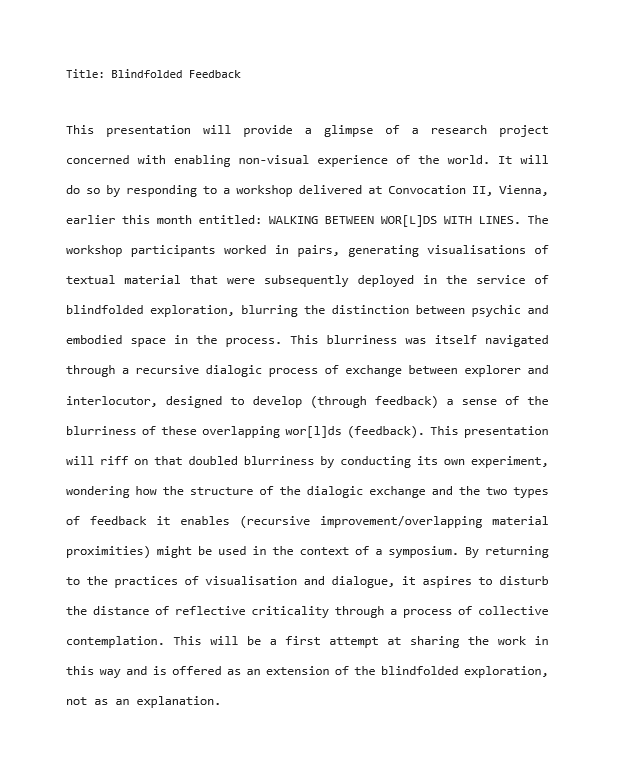
BLINDFOLDED FEEDBACK was created in response to the workshop WALKING BETWEEN WOR[L]DS WITH LINES (delivered at Convocation II, October 2023), and is intended as both documentation of that event and a work in its own right. The phrase ‘blindfolded feedback’ was generated in response to the call for ‘additional, unscheduled parallel sessions’ to the timetable during Convocation II. I proposed a feedback session that offered the chance for workshop participants to relay their experience of WALKING BETWEEN WOR[L]DS WITH LINES. However, in the event, no one could attend the allocated time for ‘blindfolded feedback’ due to the (many) other commitments already timetabled into the schedule of Convocation II. Rather than this being a problem, the difficulty of scheduling additional space and time in which the feedback could occur generated thoughts related to the workshop itself, and in particular, the imperative to re-attune to (and by default make space and time for), otherwise overlooked interpretations of the world. This in turn caused me to wonder how feedback is received when it falls outside of the allotted time ascribed to it (for I certainly received it), or the sensory modes attuned to it (for I definitely heard it), and how, by attending to feedback received as such, it might be utilised as material for reflective re-presentation: blindfolded feedback.
To explore these concerns I wrote an application to present at the University of Leeds’ Annual Practice-led PhD Symposium. That proposal can be accessed above.
For the symposium itself, I wrote a script for many voices designed to be performed through collective reading. The script is built around citations from the proposal and the workshop text for WALKING BETWEEN WOR[L]DS WITH LINES (available on the page of that name). By offering the text as a script to be performed by the room (a room whose normative attunement is that of a speaker visualising absence through a PowerPoint presentation), I (we) seek to re-attune to the room through the principles of (un)scheduled embodied, blindfolded feedback.
The script and an accompanying audio recording of the collective reading can be accessed below.
Benjamin Jenner: Script for the collective reading of BLINDFOLDED FEEDBACK.
In editing the audio recording of the collective reading, I have chosen to include the ‘voice’ of the speech to text translation service. This voice extends the interpretive imperative of the workshop WALKING BETWEEN WOR[L]DS WITH LINES by generating a new text, one whose ‘mistranslations’ will likely be utilised in future iterations of this work.
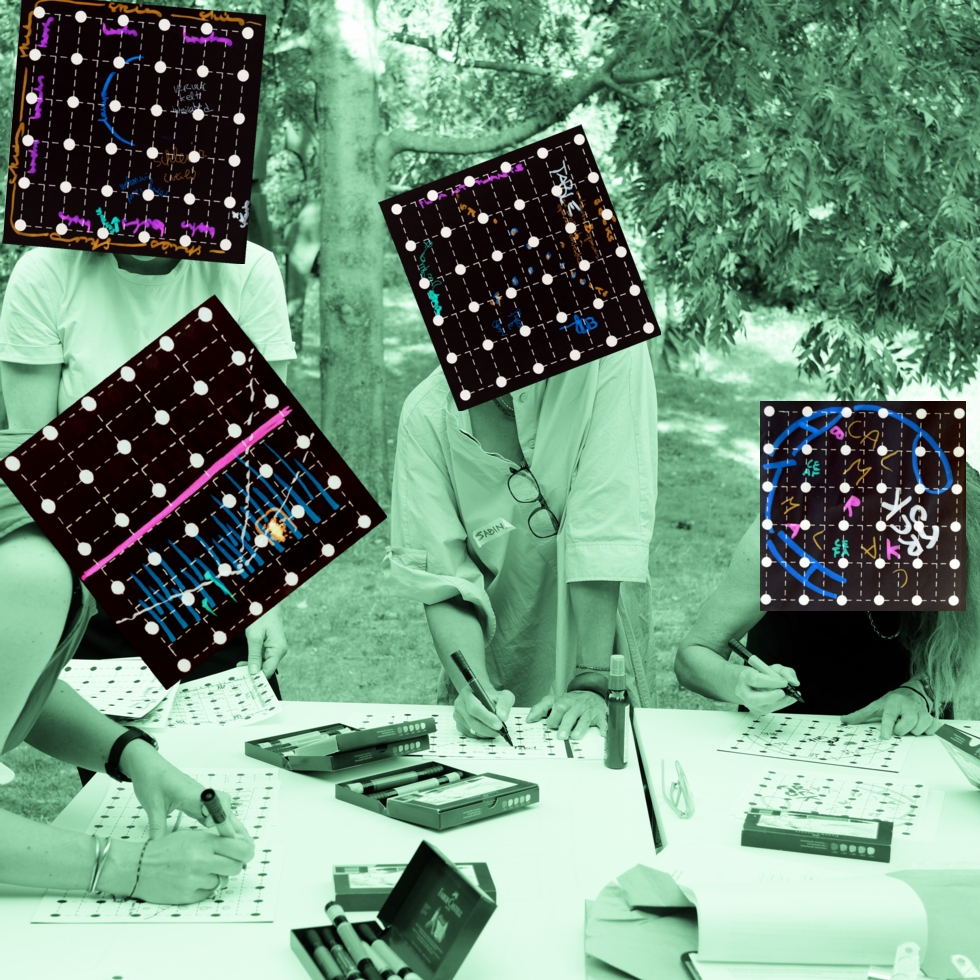
WALKING BETWEEN WOR[L]DS WITH LINES was a participatory workshop delivered at Convocation II, Vienna, in October 2023.
The workshop offered the opportunity to employ self-generated text-based images as tools for exploring a garden space without use of the eyes.
Through a visualisation process, participants were asked to imagine a space of learning that was important to them. By following a series of verbal prompts, that space was gradually transformed in mind into a spatialised arrangement of words. Those words were then translated onto a tactile paper surface as an arrangement of graphic lines, like a form of notation.
In dialogue with a sighted interlocutor the blindfolded explorer would then set out into the garden with their drawing. Rather than lead or guide the explorer, the interlocutor’s role was to support the emergence of the explorer’s blindfolded world in language in relation to the visualisation. As the exploration developed and the relationship between the garden and the visualisation began to get increasingly complex, new words were added onto the drawing by the blindfolded explorer. These new words served to both affirm the presence of the visualised space in the embodied space of the garden – windows merging with trees, tables with bushes, etc – whilst at the same time reminding both explorer and interlocutor of the mediating function of language and its role in defining experience.
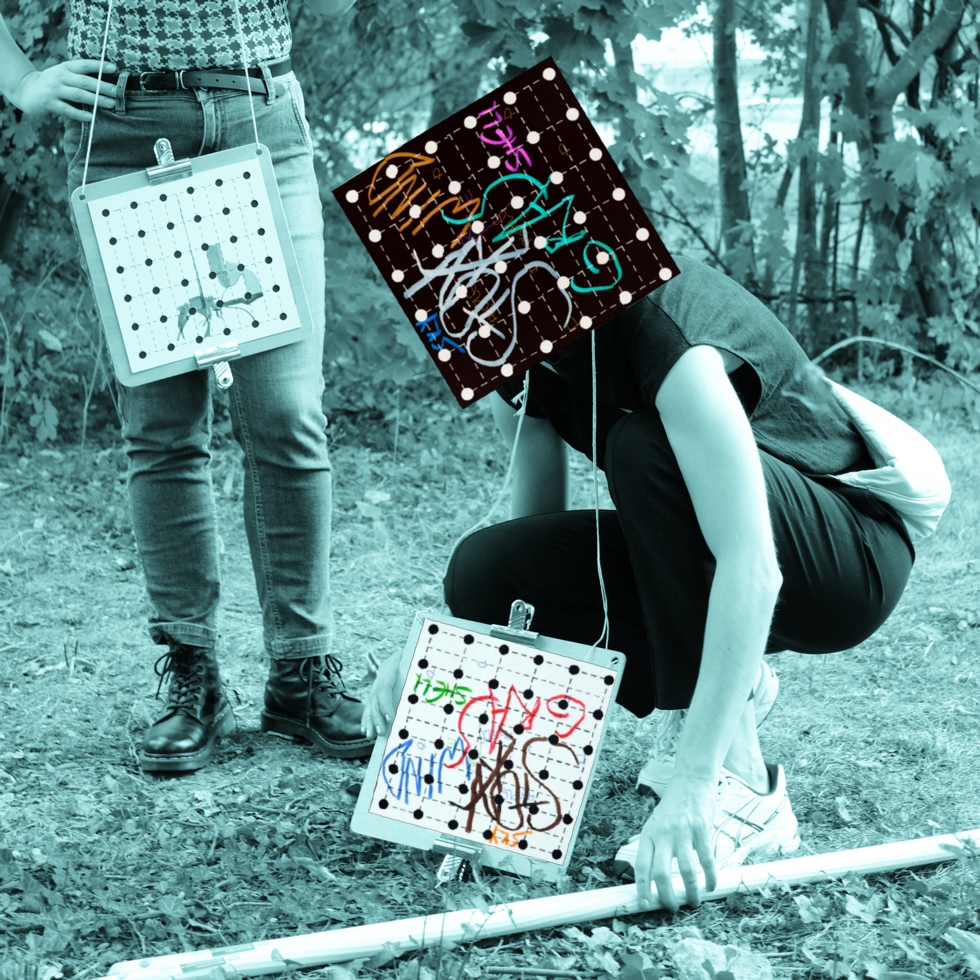
Following the workshop, I developed my workshop text into a digital booklet (available below). This text and its re-presentation is a response to the way that my understanding of the workshop developed through its facilitation. The grey text is the workshop text prepared for Convocation II; the highlighted text was written during the workshop in response to the activity; whilst the redacted text was prepared for the workshop but remained unarticulated. The images that accompany the words have been generated from the tactile grid that participants used to make their drawings. As participants explored the grid blindfolded, that structure’s temporal qualities came to the fore, enabling it to relinquish its modernist associations and blend with the garden. This blending was expressed by the participants in dialogue and through their drawings. It is represented here through the deconstruction of the grid’s formal elements in line with the participant’s discoveries.
Benjamin Jenner: WALKING BETWEEN WOR[L]DS WITH LINES: A WORKSHOP TEXT
This workshop and its ephemera are an extension of my own blindfolded explorations of space. They are intended both as a way of making the work public and of enabling others to practice and extend the processes I have developed through my research. As much as these events (workshop/workshop text) are about engaging tactics for blindfolded exploration, they are also about developing an embodied critique of the relationship between language and vision through deep listening and dialogic intra-action. This relationship is explored further in the work BLINDFOLDED FEEDBACK.
This short digital video is one of eight, made in response to LOCAL SENSES’ participation in Liberty Festival 2022, Deptford, London.
For Liberty Festival, LOCAL SENSES shared their poems, music and meditations with both attendees of the festival and local residents.
The video focuses on the words deployed by the group as they respond to the environment beyond the visual. This focus does not seek to make a narrative of this process but rather to hold open the moment of encounter between the group and the environment. As a result, many subtitles appear on screen at once making a conventional reading difficult to achieve. This encourages instead a type of reading that is more like listening, and a type of listening more attuned to the plurality of voices at play. The video also includes the voice of the speech-to-text translation service employed to generate the subtitles (rendered in green), complicating the embodied environment with the environment of translation and reproduction.
More information about the work of LOCAL SENSES can be accessed by clicking on the tab ‘LOCAL SENSES’, below.
This short digital video is one of eight, made in response to LOCAL SENSES’ participation in Liberty Festival 2022, Deptford, London.
For Liberty Festival, LOCAL SENSES shared their poems, music and meditations with both attendees of the festival and local residents.
The video focuses on the words deployed by the group as they respond to the environment beyond the visual. This focus does not seek to make a narrative of this process but rather to hold open the moment of encounter between the group and the environment. As a result, many subtitles appear on screen at once making a conventional reading difficult to achieve. This encourages instead a type of reading that is more like listening, and a type of listening more attuned to the plurality of voices at play. The video also includes the voice of the speech-to-text translation service employed to generate the subtitles (rendered in green), complicating the embodied environment with the environment of translation and reproduction.
More information about the work of LOCAL SENSES can be accessed by clicking on the tab ‘LOCAL SENSES’, below.
Animated re-presentation as digital video with additional environmental sound.
Delivered at EARN (European Artistic Research Network) Gathering, Academy of Fine Arts at University of the Arts Helsinki, Finland, 27-28th October 2022.
Subtitles added for application to CEPRA Journal, University of Leeds, 2023.
19 minutes and 42 seconds
Animated re-presentation as digital video.
HOW FAR AWAY IS THAT DOG? is the companion piece to A WALK IN AFTERNOON SUNSHINE.
30 minutes and 54 seconds
A WALK IN AFTERNOON SUNSHINE
This presentation was delivered at the conference Psychosocial Cartographies, held at the Anglo American University, Prague, Czech Republic, 17th & 18th June 2022. The presentation has been adapted in order to be housed in this space.
Animated digital re-presentation
Duration: 20 minutes and 33 seconds.
Animated re-presentation as digital video.
Delivered at CPRA (Centre for Practice Research in the Arts), UCLAN (The University of Central Lancashire), 29th April 2022.
15 minutes and 05 secs.